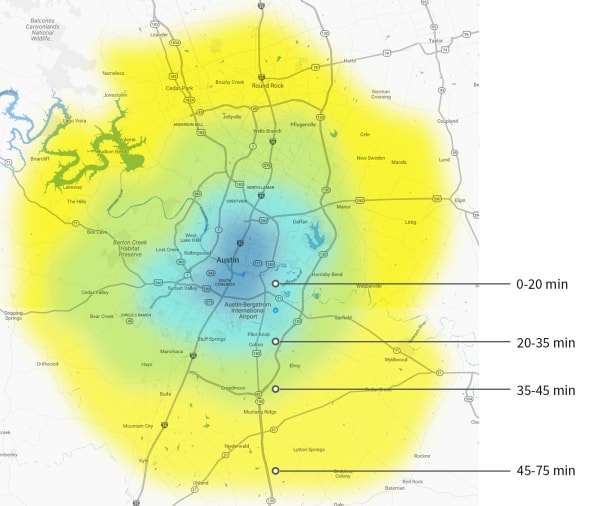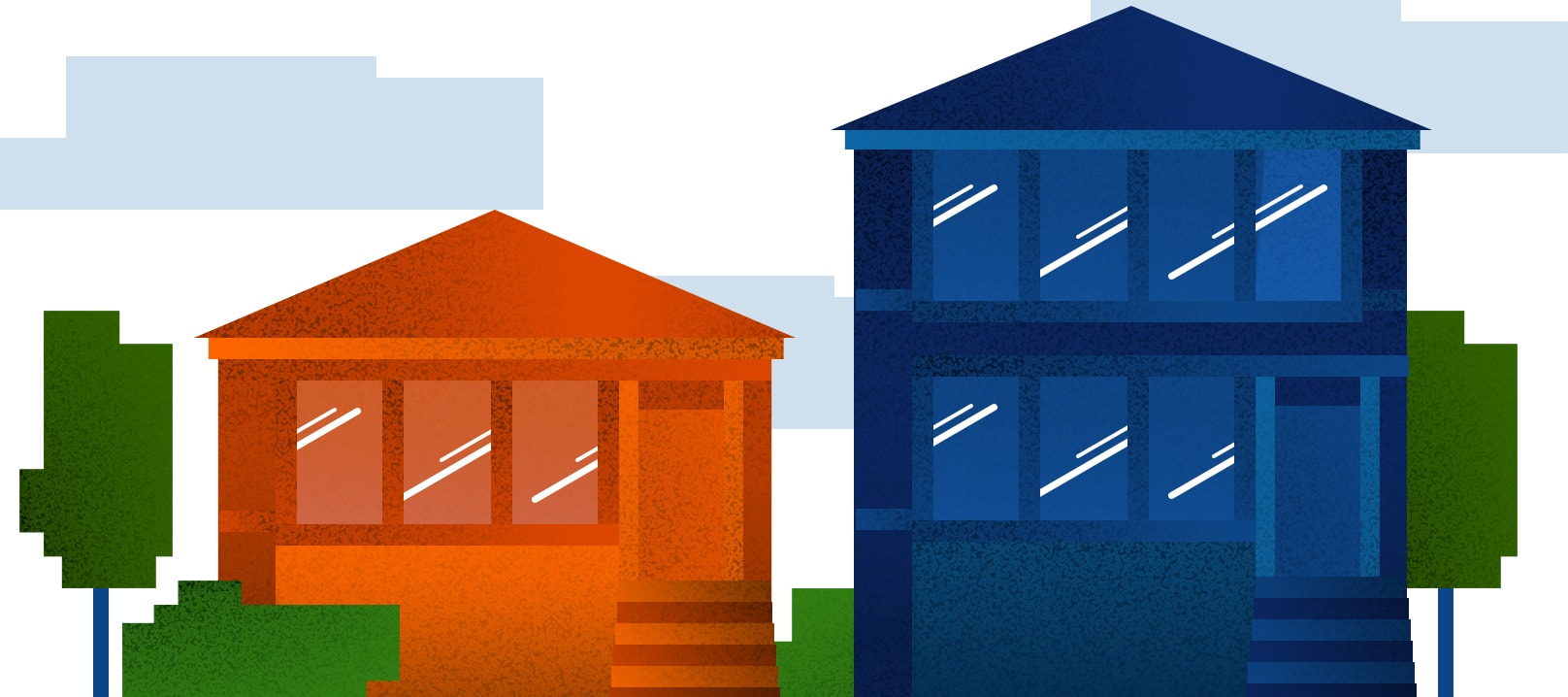Austin, TX: Cost of Living and Why to Move There
Find Cheap Renters Insurance Quotes in Your Area
Austin is routinely lauded as one of the best places to live in the United States, thanks to its warm weather, thriving economy and bustling cultural scene. But if you're considering moving to Austin, you'll have lots of different options for places to live, from family-friendly suburbs to densely packed urban areas. Here's what you should consider before making the move.
What it's like to live in Austin

Besides being the state capital of Texas, Austin is also the hub for creative culture in the state. It's home to the University of Texas at Austin, and it's as well-known for live music as it is for Tex-Mex cuisine. South by Southwest (also known as SXSW) and Austin City Limits (ACL) music festivals take over the city each spring and fall. They each provide unique opportunities to experience some of the best touring musical acts in the world, while also bringing hundreds of thousands of visitors into the city, making everyday life more challenging for residents.
Austin's key culinary exports are Tex-Mex items like queso dip and breakfast tacos, as well as Texas-style barbecue and locally brewed beer. But like any hip city, there is a huge variety of cuisines and price points, so you'll be able to find restaurants that suit your taste, whether from an inventive food truck or a high-end sushi restaurant.
Besides food and music, Austin has plenty of parks and outdoor space to enjoy. Known as the city’s crown jewel, the Barton Springs Pool is a must-visit outdoor swimming pool fed by natural springs and is three acres in size.
Cost of living in Austin
**Editor's note: Prices are based on the latest available data. However, home prices have steeply risen nationwide in the past 12 to 18 months, and these fluctuations may not be reflected here. **
Austin is a moderately expensive place to live, but it also has comparably high wages to offset the cost of living. The median home in Austin costs $378,300, which is far higher than the median in Texas ($200,400) or the United States overall ($240,500). This is somewhat balanced by high wages: The median house costs about 4.8 times the median household wage of $71,100.
Renting, by comparison, is more affordable. The median rent in Austin is $1,334, which works out to be 21.2% of the city’s monthly median household income. That's close to the same as in Texas overall (20.4%) and less than the average in Denver (22.7%).
Austin, Texas | Texas | United States | Denver, Colorado | |
|---|---|---|---|---|
| Median household income | $75,413 | $64,034 | $65,712 | $75,646 |
| Median rent | $1,334 | $1,091 | $1,097 | $1,433 |
| Rent as % of income | 21.2% | 20.4% | 20.0% | 22.7% |
| Median mortgage-related costs (SMOC) | $2,189 | $1,675 | $1,609 | $1,984 |
| Mortgage-related costs as % of income | 34.8% | 31.4% | 29.4% | 31.5% |
The cost of getting around in Austin
Austin is a fairly spread-out city, with a population density of around 3,006 people per square mile. Most people in Austin commute by car, with about 81% of people driving alone or carpooling. The next most common option is to work from home at 11%, while all others (including public transit, walking and bicycling) make up just 8%.
Since most people in Austin commute by car, the primary costs of getting around in the city come from car payments, gasoline, insurance and maintenance. The average gasoline price is cheaper in Austin than throughout the United States and slightly less expensive than the average price in Texas. According to AAA, per-gallon gas prices average $2.88 in Austin, $2.91 in Texas and $3.30 across the country.
Commute times in Austin

Car insurance is slightly more expensive in Austin than other cities in Texas. At an average of $1,920 per year, it's 3% more than the state average of $1,872.
Of course, car insurance costs vary widely by driver. The rate you'll pay is based on things like where you live, what kind of car you drive and your driving history, so always check with multiple insurers to find the best deal. It's worth noting that among insurers we surveyed, State Farm offered the best rates in Texas, with an annual premium of just $1,094 for a 30-year-old with a clean driving history.
Alternatives to car ownership
Unfortunately, those looking to live a car-free lifestyle in Austin may find it difficult. Transit options are sparse compared to other major cities: The main options are a restricted bus service throughout the city and a light rail service to North Austin. You'll likely need a car for errands and other trips, even if you can commute to work via public transit. People living near the center of the city in downtown East Austin or near the UT-Austin campus may be able to get by without an automobile, as there are more options to walk, bike and take transit than other areas.
The good news is the cost of public transit is low: Single fares are $1.25, and $2.50 will get you around for an entire day. Additionally, competition between ride-sharing companies and local ride-share app Ride Austin have made ride-sharing fares low as well.
Working in Austin
Austin has long been a software and technology industry hotbed, having been dubbed "Silicon Hills" in the 1990s. Top employers include Dell and Apple, among other big-name tech companies. High-tech manufacturing is also prevalent, as are video game production and space technology.
Austin's biggest employers
Rank | Employer | # of employees |
|---|---|---|
| 1 | State of Texas | 63,900 |
| 2 | University of Texas at Austin | 23,925 |
| 3 | H-E-B | 18,035 |
| 4 | Dell Technologies | 14,030 |
| 5 | City of Austin | 13,531 |
| 6 | Federal Government | 13,199 |
| 7 | Ascension Seton | 11,227 |
| 8 | Austin Independent School District | 11,101 |
| 9 | St. David's HealthCare Partnership | 10,836 |
| 10 | Samsung Austin Semiconductor | 8,935 |
Wages in Austin are relatively high, with a median household income of $99,227. The city also has a low unemployment rate of 3.2%, which beats out Texas overall (5.2%) and the United States as a whole (4.2%), suggesting Austin is a good place to find a job, especially if you work in a high-tech industry.
Climate of Austin
The climate of Austin, like most of Texas, is very hot during the summer and mild during the winter. Summer highs typically reach into the 90s, with several days each year exceeding 100 degrees Fahrenheit. Winters are mild, with temperatures ranging from 40 to 60 degrees Farenheit between December and February.
Austin and central Texas are notable for their variable humidity. When the wind blows in from the desert to the west, the air is very dry; when it blows from the Gulf of Mexico to the east, the air is much more humid.
Where should I live in Austin?

At an area of 271 square miles, the city of Austin is sprawling and has many different neighborhoods to choose from. They range from tightly packed urban areas with plenty of shops, restaurants and bars to quiet family-friendly suburbs. Generally, you’ll pay more as you get closer to the center of the city.
Take some time to consider where you will work (or are likely to work) before you pick where you'd like to live. Austin's traffic is notoriously bad, so if you can live close to your new workplace, you'll limit how much time you'll spend stuck in a car each day.
Median rental prices
Median home purchase prices
Downtown
Unsurprisingly, downtown is the most central, dense and expensive part of Austin. It's home to a large portion of Austin's restaurants, bars, venues and other points of interest. If you want to live in the middle of everything (and have the income to afford it), downtown is the place to be. Downtown Austin is also the most concentrated location for people to work, although not by as big of a margin as other cities.
University of Texas
The area around the University of Texas, just north of downtown Austin, is home to many college students and recent graduates, with the activities and amenities to match: You'll find inexpensive restaurants, cool shops and bars full of young people. However, the UT area is not as cheap to live here as you might expect for an area popular with college students.
South Austin
South Austin, especially the 78704 ZIP code, is the center of "Weird Austin" and full of unusual people and places to go (although the area is not as out-there as it once was). As you go farther south, the area becomes more residential and eventually more working-class.
Eastside
Historically, the eastside of Austin has primarily housed the city's Mexican and Latino population, and it has plenty of Mexican grocery stores and taco trucks to serve them (though in truth, taco trucks are just about everywhere). More recently, the area has been a popular choice for artists.
North Central/Northwest Austin
North Central and Northwest Austin are among the most historic (and most expensive) neighborhoods to live in Austin. They have beautiful old homes, which tend to be on the smaller side, as well as breweries, small cafes and upscale shops.
Greater Austin
More than half of the people who live and work in the Austin area live outside of the city, and many people commute into Austin to work. If you are looking for a little more space for a little less money, and you can handle a longer commute, consider looking beyond Austin's city line for a place to live. Some of the area's major employers are also outside of Austin proper, so your commute could actually be shorter if you move to the suburbs.
How to move to Austin

Austin is in the midst of a population boom, with more than 150 people moving to the city each day — it's the ninth-fastest growing metro area in the nation. As a result, the housing market is competitive, and you'll need to be prepared when you actually start looking for your new home.
Housing options in Austin
Like all cities, there are common benefits and options to consider when choosing a place to live in Austin. Here are some common ones, so you can decide which are must-haves and which you can live without.
- House vs. apartment: It's possible to rent either an apartment or a freestanding house in the Austin area. A house will give you more space, but an apartment is more likely to be located in a lively neighborhood. For a given area, an apartment will generally be less expensive. But some of the priciest areas, like downtown, are more apartment-heavy.
- Clothes washer and dryer: Many homes include a washer and dryer, or they have hookups so you can rent or buy your own. If a home doesn't have either, make sure there's a laundromat nearby, as hauling tons of laundry in the Austin heat is very unpleasant.
- Air conditioning: Most Austin homes have central air conditioning. When you're looking around for a place to live, ask how new the AC is. Newer AC units are more efficient than old ones and will lead to a significantly lower utility bill, since your AC will be on essentially all summer.
- Appliances: Your new place will come with a stove and refrigerator. Consider whether it's worth it paying more for a place with nicer models or additional appliances like a built-in microwave.
Finding a place and submitting an application
Austin has licensed leasing agents who know the city's landscape and can help you find a place that suits your needs in your price range. They're all licensed by the state, and landlords, not tenants pay their fees, so they won't pressure you into too expensive an apartment, nor will you have to pay for their services.
Gather all your necessary personal information before you start looking, so that when you find a place you like, you can apply right away. If you spend the night thinking about it or need a few days to gather your old pay stubs, you might find that someone else has scooped up your dream home.
You should bring:
- Checkbook, cashier’s check or money order to pay the deposit
- Photo ID
- Proof of employment or pay stubs
- References
- Credit score
Rental management companies are required to post rental application requirements publicly, so you'll usually know in advance if you meet the criteria to move into a specific place. After you're approved, you'll typically need to pay a month's deposit to move in.
Renters insurance in Austin
Renters insurance is an essential investment for renters in Austin. It only costs a few dollars per month, but it protects all your belongings if they're ever damaged or stolen. Austin renters insurance is 23% cheaper than the average in Texas, with a typical renter paying about $20 per month for $25,000 of coverage.
But the cheapest renters insurance company we found, Mercury insurance, offered the same coverage for only $12 per month. We encourage people shopping for renters insurance to check with multiple companies for the best price.
Methodology
To understand the cost of living in Austin, ValuePenguin compiled the cost of homeownership, renting an apartment, and commute data from the 2019 American Community Survey.
Median income data was collected from the U.S. Bureau of Labor Statistics.
Editorial Note: The content of this article is based on the author’s opinions and recommendations alone. It has not been previewed, commissioned or otherwise endorsed by any of our network partners.
